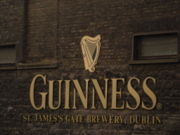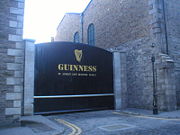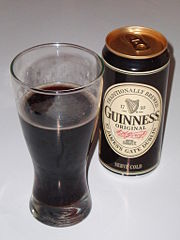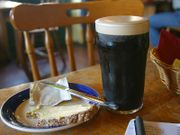Guinness
2008/9 Schools Wikipedia Selection. Related subjects: Drink
Guinness (pronounced /ˈɡɪnɪs/) is a popular dry stout that originated in Arthur Guinness' brewery at St. James's Gate in Dublin, Ireland. The beer is based on the porter style that originated in London in the early 18th century. It is one of the most successful beer brands in the world, being exported worldwide. The distinctive feature in the flavour is the roasted barley which remains unfermented. For many years a portion of the beer was aged to give a sharp lactic flavour, but Guinness has refused to confirm if this still occurs. The thick creamy head is the result of the beer being mixed with nitrogen when being served. It is extremely popular with the Irish and, in spite of a decline in consumption over recent years, is the best-selling alcoholic drink of all time in Ireland, where Guinness & Co. makes almost €2 billion annually.
The parent company has been headquartered in London since 1932 and was later merged with Grand Metropolitan plc and developed into a multi-national alcohol conglomerate named Diageo.
Composition
Guinness stout is made from water, barley malt, barley, hops, and brewer's yeast. A portion of the barley is flaked (i.e. steamed and rolled) and roasted to give Guinness its dark colour and characteristic taste. It is pasteurised and filtered. Despite its reputation as a "meal in a glass", Guinness only contains 198 kcal (838 kilojoules) per imperial pint (20 fl oz UK) (1460 kJ/ l), fewer than an equal-sized serving of skimmed milk or orange juice and most other non-light beers.
Draught Guinness and its canned counterpart contain nitrogen (N2) as well as carbon dioxide. Nitrogen is less soluble than carbon dioxide, which allows the beer to be put under high pressure without making it fizzy. The high pressure of dissolved gas is required to enable very small bubbles to be formed by forcing the draught beer through fine holes in a plate in the tap, which causes the characteristic "surge" (the widget in cans and bottles achieves the same effect). The perceived smoothness of draught Guinness is due to its low level of carbon dioxide and the creaminess of the head caused by the very fine bubbles that arise from the use of nitrogen and the dispensing method described above. "Original Extra Stout" contains only carbon dioxide, causing a more acidic taste.
Contemporary Guinness Draught and Extra Stout are weaker than they were in the 19th century, when they had an original gravity of over 1.070. Foreign Extra Stout and Special Export Stout, with abv over 7%, are perhaps closest to the original in character.
Although Guinness may appear to be black, it is officially a very dark shade of ruby.
History
Arthur Guinness started brewing ales initially in Leixlip, then at the St. James's Gate Brewery, Dublin, Ireland from 1759. He signed a 9,000 year lease at £45 per annum for the unused brewery. Ten years later on May 19, 1769 Guinness exported their product for the first time, when six and a half barrels were shipped to England.
Although sometimes believed to have originated the stout style of beer, the first use of the word stout in relation to beer was in a letter in the Egerton Manuscript dated 1677, almost 50 years before Arthur Guinness was born. The first Guinness beers to use the term were Single Stout and Double Stout in the 1840s.
Guinness brewed their last porter in 1974.
Guinness Stout is also brewed under licence internationally in several countries, including Nigeria and Indonesia. The unfermented but hopped Guinness wort extract (the essence) is shipped from Dublin and blended with beer brewed locally.
The Guinness brewery in Park Royal, London closed in 2005. The production of all Guinness sold in the UK and Ireland was switched to St. James's Gate Brewery Dublin.
The breweries pioneered several quality control efforts. The brewery hired the statistician William Sealy Gosset in 1899, who achieved lasting fame under the pseudonym "Student" for techniques developed for Guinness, particularly Student's t-distribution and the even more commonly known Student's t-test.
Controversy over proposed sale of St James's Gate
The Sunday Independent reported on 17 June 2007 that Diageo intends closing the historic St James's Gate plant in Dublin and moving to a greenfield site on the outskirts of the city. This news caused some controversy when it was announced.
The following day, the Irish Daily Mail ran a follow up story with a double page spread complete with images and a history of the plant since 1759. Initially, Diageo said that talk of a move was pure speculation but in the face of mounting speculation in the wake of the Sunday Independent article, the company confirmed that it is undertaking a "significant review of its operations". This review is largely due to the efforts of the company's ongoing drive to reduce the environmental impact of brewing at the St James's Gate plant.
On 23 November 2007, an article appeared in the Evening Herald, a Dublin newspaper, stating that Dublin City Council, in the best interests of the city of Dublin, had put forward a motion to prevent planning permission ever being granted for development of the site thus making it very difficult for Diageo to sell off the site for residential development.
On 9 May 2008, Diageo announced that the St James's Gate brewery will remain open and undergo renovations, but that breweries in Kilkenny and Dundalk will be closed by 2013 when a new larger brewery is opened near Dublin. The result will be a loss of roughly 250 jobs across the entire Diageo/Guinness workforce in Ireland. Two days later, the Sunday Independent again reported that Diageo chiefs had met with Tanaiste Mary Coughlan, Ireland's Deputy Prime Minister, about moving the plc operations to Ireland from the UK to benefit from its lower corporation tax rates. Several UK firms have made the move to pay Ireland's 12.5 per cent rate which is less than half of the UK's 28 per cent rate. Diageo released a statement to the London stock exchange denying the report.
Guinness and health
Studies claim that Guinness can be beneficial to the heart. Researchers found that antioxidant compounds in Guinness, similar to those found in certain fruits and vegetables, are responsible for health benefits because they slow down the deposit of harmful cholesterol on the artery walls.
Guinness ran an advertising campaign in the 1920s which stemmed from market research - when people told the company that they felt good after their pint, the slogan was born – "Guinness is Good for You". Guinness was told to stop using the slogan decades ago – and the firm still makes no health claims for the drink. Diageo, the company that now manufactures Guinness, said: "We never make any medical claims for our drinks." The company now runs advertisements that call for "responsible drinking".
Some vegetarians consider Guinness as unsuitable for a vegetarian diet, as the production process involves the use of isinglass, made from fish. It is used as a fining agent for settling out suspended matter in the vat. The isinglass is retained in the floor of the vat but it is possible that minute quantities might be carried over into the beer.
Varieties
Guinness stout is available in a number of variants and strengths, which include:
- Guinness Draught, sold in kegs and widget cans and bottles—4.1 to 4.3% alcohol by volume (abv); the Extra Cold is served through a super cooler at 3.5°C (38.3°F).
- Guinness Original/Extra Stout—4.2 or 4.3% abv (Ireland, UK, mainland Europe), 4.8% abv (Namibia/Southern Africa), 5% abv (Canada) and 6% abv (United States, Australia, Japan);
- Guinness Foreign Extra Stout, is a 7.5% abv version sold in Europe, Africa, the Caribbean and Asia. The basis is an unfermented but hopped Guinness wort extract shipped from Dublin, which is added to local ingredients and brewed locally. The strength can vary, for example, it is sold at 5% abv in China, 6.5% abv in Jamaica and East Africa, and 8% abv in Singapore. In Nigeria a proportion of sorghum is used. Foreign Extra Stout is blended with a small amount of intentionally soured beer.
- Guinness Special Export Stout, sold in Belgium and The Netherlands—8% abv;
- Guinness Bitter, an English-style bitter beer—4.4% abv;
- Guinness Extra Smooth, a smoother stout sold in Ghana, Cameroon and Nigeria—5.5% abv;
- Malta Guinness, a non-alcoholic sweet drink, produced in Nigeria and exported to the UK and Malaysia;
- Guinness Mid-Strength, a low-alcohol stout being test-marketed in Limerick, Ireland from March 2006 and Dublin from May 2007—2.8% abv;
- Guinness Red, brewed in exactly the same way as Guinness except that the barley is only lightly roasted so that it produces a lighter, slightly fruitier red ale, began test-marketing in Great Britain in February 2007—4.1% abv.
- In October 2005, Guinness introduced the Brewhouse Series — a limited-edition collection of draught stouts available for roughly six months each. The first stout in the series was Brew 39, which was released in Dublin from late 2005 until early 2006. It had the same alcohol content (ABV) as Guinness Draught, used the same gas mix and settled in the same way, but had a slightly different taste. Many found it to be lighter in taste, somewhat closer to Beamish stout than standard Irish Guinness.
- In May 2006, the second in the Brewhouse Series was introduced, named Toucan Brew after the famous Guinness toucan seen in many advertisements for the stout. This beer had a crisper taste with a slightly sweet aftertaste due to its triple-hopped brewing process.
- The third of the series—North Star—was released in October 2006 and availability was extended into late 2007 at which point it gradually disappeared from bars. Three million pints of North Star were sold in the latter half of 2007. Despite an announcement in June 2007 that the fourth Brewhouse stout would be launched in October that year, no new beer appeared and, at the end of 2007, the Brewhouse series appeared to have been quietly cancelled.
- In March 2006, Guinness introduced the "surger" in Great Britain. The surger is a plate-like electrical device meant for the home. It sends ultrasonic waves through a Guinness-filled pint glass to recreate the beer's "surge and settle" effect. The device works in conjunction with special cans of surger-ready Guinness. Guinness tried out a primitive version of this system in 1977 in New York. The idea was abandoned until 2003, when it began testing the surger in Japanese bars, most of which are too small to accommodate traditional keg-and-tap systems. Since then, the surger has been introduced to bars in Paris, but there is no intention of making it available to the French public. Surgers are also in use in Australia and Athens, Greece. The surger for the USA market was announced on November 14, 2007; plans are to make the unit available to bars only.
- Withdrawn Guinness variants include Guinness's Brite Lager, Guinness's Brite Ale, Guinness Light, Guinness XXX Extra Strong Stout, Guinness Cream Stout, Guinness Gold, Guinness Pilsner, Guinness Breó (A slightly citrusy wheat beer), Guinness Shandy and Guinness Special Light.
- For a short time in the late 1990s, Guinness produced the "St James's Gate" range of craft-style beers, available in a small number of Dublin pubs. The beers were: Pilsner Gold, Wicked Red Ale, Wildcat Wheat Beer and Dark Angel Lager.
- A brewing byproduct of Guinness, Guinness Yeast Extract (GYE), was produced until the 1950s.
Pouring and serving
What Diageo calls the "perfect pint" of Draught Guinness is the product of a lengthy "double pour", which according to the company should take 119.5 seconds. Guinness has promoted this wait with advertising campaigns such as " good things come to those who wait".
Ideally a pint of Guinness should be served in a slightly tulip shaped pint glass as opposed to the taller European tulip glass or 'Nonic' glass which contains a ridge approx 3/4 of the way up the glass. On the way to the tap, the beer is passed through a chiller and is forced through a five-hole disc restrictor plate in the end of the tap, which increases the fluid pressure and friction, forcing the creation of small bubbles which form a creamy head. The glass is then rested until the initial pour settles, and the remainder of the glass is then filled with a slow pour until the head forms a slight dome over the top of the glass. Some bartenders also draw a simple design, using the flow of Guinness from the head of the tap, such as a shamrock in the head during the slow pour.
This tradition comes from when Guinness was served from the cask, and initially older beer was poured into a glass until it was 3/4 full, then left to stand. When ordered by the customer, the glass was topped up from younger, gassier beer, producing the traditional head. As the beer is no longer blended from different ages of beer, the double pour is no longer required for the mixing of beers but is still maintained as it produces a better pint as the head does not over fill the glass and need to be discarded.
Sinking bubbles
A long time subject of bar conversations is the Guinness cascade, where the gas bubbles appear to travel downwards in a pint glass of Guinness.
The effect is attributed to drag; bubbles that touch the walls of a glass are slowed in their travel upwards. Bubbles in the centre of the glass are, however, free to rise to the surface, and thus form a rising column of bubbles. The rising bubbles create a current by the entrainment of the surrounding fluid. As beer rises in the centre, the beer near the outside of the glass falls. This downward flow pushes the bubbles near the glass towards the bottom. Although the effect occurs in any liquid, it is particularly noticeable in any dark nitrogen stout, as the drink combines dark-coloured liquid and light-coloured bubbles.
Advertising
Guinness uses the harp of Brian Boru as its trademark. This harp from approximately the 14th century, which is on view at Trinity College, Dublin, has been a symbol of Ireland since the reign of Henry VIII (16th century). Guinness adopted the harp as a logo in 1862; however, it faces left instead of right, as in the Irish coat of arms.
Guinness has a long history of marketing campaigns, from award-winning television commercials to beer mats and posters.
Guinness's iconic stature is partly due to its advertising. The most notable and recognisable series of adverts was created by Benson's advertising, primarily drawn by the artist John Gilroy, in the 1930s and '40s. Benson created posters that included phrases such as "Guinness for Strength", "Lovely Day for a Guinness", "Guinness Makes You Strong," "My Goodness My Guinness," (or, alternatively, "My Goodness, My Christmas, It's Guinness!") and most famously, "Guinness is Good For You". The posters featured Gilroy's distinctive artwork and more often than not featured animals such as a kangaroo, ostrich, seal, lion, and notably a toucan, which has become as much a symbol of Guinness as the harp. (An advertisement from the 1940s ran with the following jingle: "Toucans in their nests agree/Guinness is good for you/Try some today and see/What one or toucan do.") Dorothy L. Sayers, then a copywriter at Benson's, also worked on the campaign; a biography of Sayers notes that she created a sketch of the toucan and wrote several of the adverts in question. Guinness advertising paraphernalia, notably the pastiche booklets illustrated by Ronald Ferns, attracts high prices on the collectible market.
In the late 1980s and early 1990s in the UK there was a series of humorous adverts featuring Rutger Hauer.
The 1994-1995 Anticipation campaign, featuring actor Joe McKinney dancing to "Guaglione" by Perez Prado while his pint settled, became a legend in Ireland and put the song to number one in the charts for several weeks. The advertisement was also popular in the UK where the song reached number two.
In 2000, Guinness's 1999 advertisement Surfer was named the best television commercial of all time in a UK poll conducted by The Sunday Times and Channel 4. This advertisement is inspired by the famous 1980s Guinness TV and cinema ad, centred on a surfer riding a wave. The 1980s advertisement not only remained a popular iconic image in its own right but also entered the Irish cultural memory through inspiring a well known line in Christy Moore's song " Delirium Tremens". Surfer was produced by the advertising agency Abbott Mead Vickers BBDO; the advertisement can be downloaded from their website.
Guinness won the 2001 Clio Award as the Advertiser of the Year, citing the work of five separate ad agencies around the world.
In 2003 the Guinness TV campaign Template:Deadlinks featuring Tom Crean won the gold Shark Award at the International Advertising Festival of Ireland, while in 2005 their Irish Christmas campaign took a silver Shark. This TV ad has been run every Christmas since 2003 and features pictures of snow falling in places around Ireland, evoking the James Joyce story The Dead, finishing at St. James's Gate Brewery with the line "Even at the home of the black stuff they dream of a white one".
Their UK commercial noitulovE, first broadcast in October 2005, was the most-awarded commercial worldwide in 2006 In it, three men drink a pint of Guinness, then begin to both walk and evolve backward. Their 'reverse evolution' passes through an ancient homo sapiens, a monkey, a flying lemur, a pangolin, an ichthyasaur and a velociraptor until finally settling on a mud skipper drinking dirty water, which then expresses its disgust at the taste of the stuff, followed by the line "Good Things Come To Those Who Wait". The official name of the ad is "Noitulove"—which is "Evolution" backwards. This was later modified to have a different endings to advertise Guinness Extra Cold, often shown as "break bumpers" at the beginning and end of commercial breaks. The second endings show either the homo sapiens being suddenly frozen in a block of ice, the ichthyasaurs being frozen whilst swimming, or the pool of muddy water freezing over as the mud skipper takes a sip, freezing his tongue to the surface.
Guinness's 2007 advert, directed by Nicolai Fuglsig and filmed in Argentina is titled "Tipping Point". It involves a large-scale domino chain-reaction and, with a budget of £10m, is the most expensive advertisement for the company so far.
Guinness worldwide sales
Sales of Guinness in Britain and Ireland declined 7% in 2006.
Guinness has a significant share of the Africa beer market, where Guinness has been sold since 1827. About 40 per cent of worldwide total Guinness volume is brewed and sold in Africa, with Foreign Extra Stout the most popular variant. The Michael Power advertising campaign was a critical success for Guinness in Africa, running for nearly a decade before being replaced in 2006 with "Guinness Greatness".
In 2006, Canada was the fastest growing Guinness draught market in the world and on St. Patrick's Day in 2006, more Guinness was sold in Canada than in Ireland.
Guinness sales in the United States showed a 9% increase.
Merchandising
During Saint Patrick's Day outside Ireland, Guinness merchandise is available in many places that sell the drink. Merchandise includes clothing and hats, often available from behind the bar after a specified number of pints of Guinness have been purchased.
There is a popular tourist attraction for Guinness at St. James's Gate Brewery in Dublin, called the Guinness Storehouse, where a self-guided tour of the attraction starts with an overview of the ingredients used to make Guinness followed by a step-by-step description of how Guinness is made. After this a small amount of Guinness is provided to follow with a video of how Guinness is regularly tested by a panel of tasters and the visitor is shown how to properly taste Guinness. The rest of the tour includes many things such as the coopering trade within Guinness many years ago, a section dedicated to the advertising and merchandising efforts of Guinness over the years, and a section dedicated to historical artifacts and footage relating to Guinness. The tour finishes with a free pint of Guinness at the top of the building in the Gravity Bar, where the pint may be enjoyed with a 360-degree view of Dublin. A bar and a restaurant are available to visitors during the tour and a full selection of Guinness merchandise is available to purchase.
Cooking
Guinness is often used as an ingredient in cooking, typically in stews or pies or as a base for a batter in which fish is deep fried.
In Malaysia, crab and pork ribbed cooked in Guinness Stout are common dishes available at Chinese restaurants.




